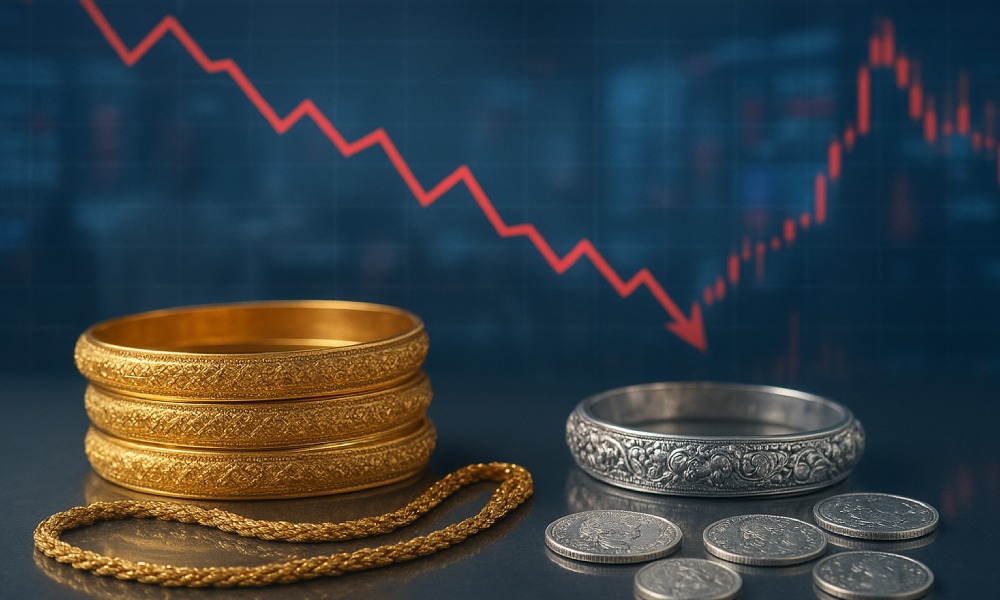National News
┬ĀTrump’s reciprocal tariffs spark job loss fears in GJ sector

The U.S. government’s move to impose reciprocal tariffs has sent ripples of concern through India’s gem and jewellery sector, a vital component of the nation’s economy. Here’s a breakdown of the key issues and implications:
The Core Issue: Reciprocal Tariffs and Trade Imbalance
Unequal Tariff Structures: The heart of the issue lies in the perceived imbalance in tariff structures between the U.S. and India. India currently levies a 20% tariff on gold jewellery imported from the U.S., while the U.S. applies a significantly lower duty of 5.5-7% on Indian gold jewellery. Similarly, India imposes a 5% tariff on cut and polished diamonds, whereas the U.S. has historically maintained zero tariffs on these Indian exports. This discrepancy has prompted the U.S. to consider reciprocal tariffs, aiming to create a more level playing field.
Potential Impact on Exports: The U.S. is a critical market for Indian gem and jewellery exports. Any increase in U.S. tariffs would directly raise the cost of Indian products for American consumers, potentially reducing demand and negatively impacting export volumes.
Key Export Categories at Risk: The primary export categories facing potential disruptions include:
ŌĆó Cut and polished diamonds: A major export segment, historically enjoying tariff-free access to the U.S. market.
ŌĆó Studded gold jewellery: A significant contributor to export revenue.
ŌĆó Plain gold jewellery: Another essential export commodity.
ŌĆó Lab-grown diamonds: A growing sector within the Indian gem and jewellery industry.
Economic and Social Implications for India
ŌĆó Impact on Export Revenue: A decline in gem and jewellery exports would directly affect India’s foreign exchange earnings.
ŌĆó Employment Concerns: The industry is a significant employer, providing livelihoods to over two million people, with a substantial portion being women and individuals from economically disadvantaged backgrounds. Tariff-induced disruptions could lead to job losses and economic hardship for these vulnerable populations.
ŌĆó Industry Vulnerability: While not the single largest export driver, the gem and jewellery sector holds a vital position in India’s economy. Its labor intensive nature, and the high value of its exports makes it very important.
ŌĆó Trade Relations: The tariff issue has the potential to strain trade relations between India and the U.S., potentially impacting other areas of economic cooperation.
Factors to Consider
ŌĆó Market Dynamics: The extent of the impact will depend on the magnitude of the tariff hikes and the ability of Indian exporters to absorb the increased costs or find alternative markets.
ŌĆó Negotiations: The outcome will also depend on the results of ongoing or future trade negotiations between the two countries.
ŌĆó Lab-grown Diamonds: The lab-grown diamond market is fairly new, and very dynamic. Any tariff changes could drastically alter the market share of Indian companies in the United States.
In essence, the potential imposition of reciprocal tariffs by the U.S. poses a significant challenge to India’s gem and jewellery industry, with potential ramifications for export revenue, employment, and overall economic stability.
National News
Gold,┬Ā silver price decline continues, downward momentum may continue┬Ā in the short term

Gold and silver prices in India continued their downward trend for the third consecutive day, following record highs seen just before Dhanteras 2025. By the end of TuesdayŌĆÖs trading session, gold was down 2.06%, closing at Rs.1,18,461 per 10 grams, while silver dropped 1.36% to Rs.1,41,424 per kilogram. On the Multi Commodity Exchange (MCX), gold opened 0.7% lower at Rs.1,20,106 per 10 grams, compared to the previous sessionŌĆÖs Rs.1,20,957. Silver also registered a similar decline, opening 0.69% lower at Rs.1,42,366 per kilogram.
The fall comes after a strong two-month rally, with traders now booking profits amid changing global cues. After a solid two-month rally, gold and silver prices came under heavy selling pressure as both metals slipped below key psychological levels ŌĆö $4,000 for gold and $47 per ounce for silver. The decline is being driven by a stronger dollar index and renewed optimism over US trade discussions with China and India.
Analysts opine that gold prices continue to decline as safe-haven demand weakens amid optimism over a potential USŌĆōChina trade deal and a stronger US dollar.Investors considering gold as a hedge should prepare for short-term volatility and sharp price swings Experts attribute this continued weakness to profit booking and global market cues. Many analysts warn that the downward momentum may persist in the short term, urging investors to monitor price movements before making fresh purchases.Despite the current dip, gold remains significantly higher than pre-festive season levels, highlighting ongoing volatility in the bullion market
-

 National News2 days ago
National News2 days agoCandere by Kalyan Jewellers – Stack Jewellery for Men: A Guide to Layering and Expression
-

 National News2 hours ago
National News2 hours agoGold,┬Ā silver price decline continues, downward momentum may continue┬Ā in the short term
-

 GlamBuzz3 hours ago
GlamBuzz3 hours agoBollywood Stars Dazzle in Festive Glamour
-

 International News3 hours ago
International News3 hours agoGold corrects 12% and Silver 15% in a week AUGMONT BULLION REPORT





